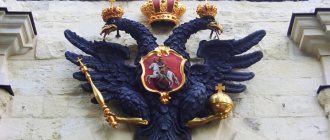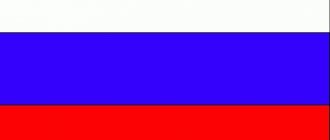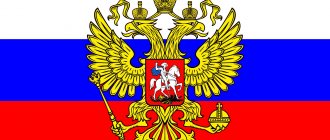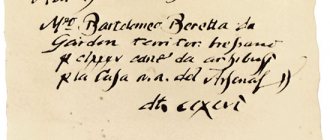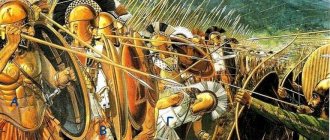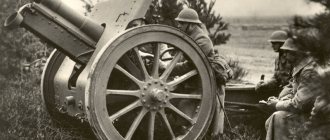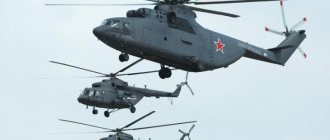Description of the coat of arms and symbolic meaning
The coat of arms of Russia is depicted in the form of a red heraldic shield, on which is a golden double-headed eagle with its wings spread. Above each eagle's head is a crown, with another one between them, and they are all connected by a gold ribbon. The eagle has a scepter in its right paw, and an orb in its left. A red shield is painted on the bird’s chest, on which a horseman is depicted slaying a dragon with his silver spear.
All images located on the coat of arms have a special meaning. The image of a double-headed eagle comes from the Byzantine Empire. The placement of this bird by the rulers on the Russian coat of arms showed the political connection between Russia and Byzantium, the exchange of cultures and the adoption of Christianity.
Three crowns symbolize the independence of the Russian state. Initially, they had a different meaning - they symbolized the three khanates that the Moscow princes were able to subjugate. The scepter and orb symbolize state power. The horseman depicted on the small shield is none other than St. George the Victorious, who triumphs over evil. He is considered the personification of the defender of Russia, patronizes Moscow and is depicted on its coat of arms.
Double-headed eagle - heritage of ancestors
160 years ago, on April 11, 1857, Russian Tsar Alexander II approved the state emblem of Russia - the double-headed eagle. In general, the coat of arms of the Russian state was modified under many tsars. This happened under Ivan the Terrible, Mikhail Fedorovich, Peter I, Paul I, Alexander I and Nicholas I. Each of these monarchs made some changes to the state emblem.
But a serious heraldic reform was carried out during the reign of Alexander II in 1855-1857. At his order, specifically for work on coats of arms, the Department of Heraldry of the Senate created the Armorial Department, which was headed by Baron B. Kene. He developed a whole system of Russian state emblems (Big, Middle and Small), focusing in their artistic embodiment on the generally accepted norms of European monarchical heraldry. Also, under the leadership of Kene, the design of the eagle and St. George was changed, and the state coat of arms was brought into compliance with international rules of heraldry. On April 11, 1857, Alexander II approved the coat of arms of the Russian Empire - a double-headed eagle. The entire set of state emblems was also approved - Large, Middle and Small, which were supposed to symbolize the unity and power of Russia. In May 1857, the Senate published a Decree describing new coats of arms and the norms for their use, which existed until 1917 without any significant changes.
The legacy of ancestors
The coat of arms and colors of a nation carry symbolic and historical meaning. It must be remembered that state symbols (a figurative expression of statehood, a nation, its ideology) occupy an extremely important place in the life of the people, although in everyday life this is usually unnoticeable. The oldest Russian symbols, which originate from the times of the Indo-European Aryans, were the solstice, the falcon-rarog, the double-headed eagle, and the color red.
One of the historical emblems of Rus'-Russia is the double-headed eagle. In terms of its antiquity and depth of meaning, it is second only to the horseman slaying the dragon-snake, who in a later, already Christian understanding, is known as St. George the Victorious. The horseman symbolizes the thunderer (Perun, Indra, Thor, etc.), who strikes the snake (symbol of Veles-Volos, the lord of Navi). This is one of the basic myths of the Indo-European Aryans.
The double-headed eagle (bird) is noted in a wide variety of cultures. In particular, in Sumerian and Indian mythologies. Thus, Gandaberunda is a two-headed bird in Vedic (Hindu) mythology (2nd millennium BC). The name of this bird consists of two words - ganda (strong), berunda (two-headed). The Vishnu Purana tells that the warrior god Vishnu turned into Gandaberunda when the ordinary weapons he owned were not enough and it was necessary to show fantastic strength: the double-headed eagle could easily lift an elephant or lion in each paw and beak. This image of Gandaberunda was preserved not only on medieval coins, but also on the bas-relief of the Rameshwar temple in the Indian city of Keladi, which was built in the 16th century, as well as in the coat of arms of the kingdom (principality) of Mysore, where Gandaberunda holds an elephant in each paw. Gandaberunda is also known as the emblem of the dynasty of the kings of Mysore - the Wodeyars, on a number of gold and copper coins of the powerful Vijayanagar Empire (south India) of the 13th-16th centuries.
Principality of Mysore (India)
Gandaberunda was perceived by Indians not only as a symbol of the warrior god Vishnu, his supreme power and military strength, but also as an avatar (incarnation) of Vishnu, he also symbolized the observance of the principles of dharma (discipline and order). In addition, in Buddhism, the double-headed eagle symbolized the strength and power of the Buddha.
This symbol was also actively used in northern Indo-European (Aryan) cultures. It must be said that the multi-headed nature of various animals and mythical creatures is one of the features of Slavic mythology.
It is not for nothing that another of the most ancient symbols of the superethnos of the Rus is Triglav, the triune God watches over all the kingdoms of the earth: Reality, Rule and Navy (in India it is known as Trimurti, in Christianity - the Trinity). Various Two-Heads, Triglav-Troyans, four-headed Svyatovids-Sventovids, Semiglavas, etc. are a sign of the superethnos of the Rus.
The double-headed eagle was especially common in ancient times in Asia Minor and the Balkan Peninsula. In Asia Minor it has been found since the time of the powerful power of the 2nd millennium BC. e. - Hittite kingdom. Its founders were the Indo-European Aryans, whose ancestral home was presumably the Balkan Peninsula. The Hittite Empire successfully competed with Egypt. The Hittites were among the first to master the secret of iron smelting and controlled all of Asia Minor and the straits from the Mediterranean to the Black Sea. It was a great Aryan (Indo-European) people who worshiped the gods Pirva (Perun) and Sivat (Light). The coat of arms of the Hittites was a double-headed eagle, which was preserved not only on standards, stone bas-reliefs, but also on seals. The Hittite eagle is the most important, material evidence of the continuity of Indo-European cultures, the continuity of empires.
Gandaberunda at Rmeshwara Temple in Keladi, India
Double-headed eagle - symbol of the Hittite kingdom
However, the Hittites also adopted the eagle from the more ancient Aryan culture. There are also more ancient settlements in Anatolia. In particular, an excavation near the settlement of Alacha-Uyuk (English form - Aladzha-huyuk"). This is a settlement of the Bronze Age - IV - III millennium BC. e. And here, along with numerous sculptural and bronze images of swastika-solstice and other Aryan-Indo-European traditional symbols, amulets, reliefs of a double-headed eagle were discovered. Thus, we observe the oldest continuity of Aryan-Indo-European culture: Alacha IV millennium BC. e. — Hattusa II millennium BC e. — Byzantium I-II millennium AD e. — Rus' XV-XXI centuries. n. e.
Russian heraldists noted that the image of a double-headed eagle was known in ancient Pteria (a city in Media). It dates back to the turn of the 7th-6th centuries. BC e. According to Xenophon, at about the same time the Persians used the eagle as a symbol of supreme power. The double-headed eagle symbol was used by the Persian shahs of the Sassanid dynasty. In ancient times, the eagle and lion were considered a symbol of royalty. In Ancient Rome, Roman commanders had images of an eagle on their staffs, it was a symbol of supremacy over the troops. Later, the eagle became an exclusively imperial sign, symbolizing supreme power.
Western heraldists of the 17th century told the legend of how the double-headed eagle became the state emblem of Rome. When Julius Caesar entered Rome, an eagle flew over him, attacked two kites, killed them and threw them at the feet of the great commander. The surprised Julius considered this a sign that predicted victory for him and ordered it to be immortalized by adding a second head to the Roman eagle. However, most likely, the appearance of the second head should be attributed to a later time, when the empire was divided into two parts - the Eastern and Western Roman Empires. The eagle had a single body, which meant common interests and origin, but with two heads facing west and east. Such an eagle was adopted as the emblem of the empire by Constantine the Great (272 - 337), or, according to other sources, by Justinian I (483 - 565). Apparently, much later, the same symbolic meaning was attached to the double-headed eagle of Austria-Hungary.
But the double-headed eagle was not the official symbol of the Byzantine Empire, as many believe. It was the emblem of the Palaiologan dynasty, which ruled from 1261 to 1453, and not the entire Byzantine state. In the Muslim world, which adopted ancient Indo-European (Aryan) symbolism, the double-headed eagle personified the highest, including military, power of the Sultan, who was presented as a warrior-hero, distinguished by courage, the will to win and belligerence. The double-headed eagle was located on the flag of the Seljuk Turks. It was used by the Konian Sultanate (Iconian Sultanate, or Rum Sultanate, or Seljuk Sultanate), a feudal state in Asia Minor that existed from 1077 to 1307. The double-headed eagle has been preserved as a symbol of Konya.
Konya
Emblem of the Palaiologan dynasty
After the start of the Crusades, the double-headed eagle appears in Western European heraldry. Thus, it is marked on the coins of Ludwig of Bavaria and the coats of arms of the burgraves of Würzburg and the counts of Savoy. The German king and Holy Roman Emperor Frederick I Barbarossa (1122 - 1190) was the first to use a black double-headed eagle in his coat of arms. Frederick saw this symbol in Byzantium. Until 1180, the double-headed eagle was not marked on state seals, coins and regalia, as well as on the personal belongings of the emperor. Previously, the symbol of the German rulers was a single-headed eagle, but starting with Emperor Frederick Barbarossa, both symbols began to be depicted on the coat of arms of the Holy Roman Empire. Only from the 15th century did the double-headed eagle become the state emblem of the Holy Roman Empire. The eagle was depicted black on a golden shield, with golden beaks and claws, its heads surrounded by halos. In the 19th and early 20th centuries, the double-headed eagle was the coat of arms of Austria-Hungary. In addition, in Serbia, the double-headed eagle became the coat of arms of the Nemanjić family. It was the ruling dynasty in the XII-XIV centuries.
Double-headed eagle on the coat of arms of the Holy Roman Empire
Rus
In Rus', the double-headed eagle was noted in the 13th century in the Chernigov principality, and in the 15th century in the Tver and Moscow principalities. The double-headed eagle also had some circulation in the Golden Horde. A number of coins of the Golden Horde with the image of a double-headed eagle have been preserved. Some researchers even claim that the double-headed eagle was the state emblem of the Horde. But most historians do not support this version. On the seal of Ivan III Vasilyevich, which was inherited from Vasily II Vasilyevich, a lion was depicted, which was tormenting a snake (the lion was a symbol of the Vladimir principality). At the end of the 15th century, two new symbols appeared: the horseman (rider), which was used in the Old Russian state, and the double-headed eagle. The formal reason for using this symbol was the fact that the wife of Ivan III was Sophia Paleologus, for whom the eagle was a family sign. The Palaiologan emblem was a black silhouette woven with black silk on a golden field. It was devoid of plasticity and internal design, essentially being a flat ornamental emblem.
Thus, the double-headed eagle was known in Rus' even before the arrival of the Byzantine princess. For example, the Chronicle of the Council of Constance by Ulrich von Richsenthal from 1416 contains the coat of arms of Rus' with the image of a double-headed eagle. The double-headed eagle was not a symbol of the Byzantine Empire, and the great Russian princes adopted it to emphasize their equality with Western European monarchs, to be equal to the German emperor.
Przemysl land (XIII century)
Principality of Chernigov
Sovereign Ivan III took the appearance of this emblem in the Russian kingdom very seriously. For the contemporaries of the Grand Duke, the kinship of the Byzantine imperial dynasty with the house of Rurik was an act of enormous significance. In fact, Rus' disputed the rights of the strongest state in Western Europe - the Holy Roman Empire - to this symbol. The Moscow Grand Dukes began to be relied upon as successors to the Roman and Byzantine emperors. From the first half of the 16th century, Elder Philotheus formulated the concept of “Moscow—the third Rome.” According to this concept, there were two Romes in history, the third stands (Moscow), and “there will not be a fourth.” Moscow became the heir to the Christian and messianic traditions of Rome and Constantinople. Ivan III the Great accepted this coat of arms not only as a dynastic sign of his wife, but as a heraldic symbol of the Russian state in the future. The first reliable use of the double-headed eagle as a state symbol of the emblem dates back to 1497, when the grand ducal charter for the land holdings of the appanage princes was sealed with a seal on red wax. The front and back sides of the seal bore images of a double-headed eagle and a horseman slaying a serpent. At the same time, images of a gilded double-headed eagle on a red field appeared on the walls of the Faceted Chamber in the Kremlin.
The Byzantine eagle on Russian soil acquired new features and became “Russianized.” In Rus', a previously simplified, lifeless graphic silhouette is filled with flesh, comes to life, and is ready to fly. This is a powerful, formidable bird. The eagle's chest is covered by the oldest, primordial Russian symbol - the Heavenly Warrior, the Conqueror of Evil, the patron of the military principle of Rus' (Perun - St. George the Victorious). The eagle was depicted in gold on a red field.
During the reign of Tsar Ivan IV, the double-headed eagle finally became the coat of arms of Russia. At first, the coat of arms of the Russian kingdom was supplemented by a unicorn, and then by a rider-snake fighter. The horseman was traditionally perceived as an image of the sovereign - “the great prince on horseback, and having a spear in his hand.” That is, the Tsar in Rus', according to the ancient Aryan tradition, was the incarnation of Perun - St. George the Victorious - defender of Truth on Earth. Before the reign of Mikhail Romanov, there were two crowns above the eagle’s heads. Between them was depicted a Russian eight-pointed cross - a symbol of Orthodoxy. Only in the great seal of Boris Godunov the eagle first appears with three crowns; they denoted the Kazan, Astrakhan and Siberian kingdoms. The third crown finally appeared in 1625, it was introduced instead of the cross. From that time on, three crowns meant the Holy Trinity; at a later time, from the end of the 19th century, they began to be considered a symbol of the trinity of the three parts of the Russian superethnos - Great Russians, Little Russians and Belarusians. Since the reign of Alexei Mikhailovich, the Russian eagle almost always holds a scepter and orb in its hands.
From the 15th to the mid-17th century, the Russian eagle was always depicted with lowered wings, which was determined by the eastern heraldic tradition. Only on some seals of False Dmitry, obviously under Western influence, the eagle’s wings are raised. In addition, on one of the seals of False Dmitry I, the serpent fighter rider was turned to the right according to the Western European heraldic tradition.
During the reign of Tsar Peter Alekseevich, with the approval of the Order of St. in 1699. Andrew the First-Called, the Moscow coat of arms is almost always surrounded by the chain of the order. The double-headed eagle itself. Under the influence of Western traditions, it becomes black. Since 1727, the horseman began to be officially called Saint George. Under Empress Anna Ioannovna, the specially invited engraver I. K. Gedlinger prepared the State Seal by 1740, which, with minor changes, would last until 1856. Emperor Pavel Petrovich, who became the Grand Master of the Order of Malta, in 1799 will introduce a Maltese cross on the chest into the Russian coat of arms, on which the Moscow coat of arms will be placed. Under him, an attempt will be made to develop and introduce the full coat of arms of the Russian Empire. By 1800, a complex coat of arms will be prepared, which will have 43 coats of arms. But before the death of Paul they will not have time to adopt this coat of arms.
Coat of arms of the Moscow Principality (XV century)
Coat of arms of the Russian Kingdom (XVII century)
State emblem of Russia (1730)
Russian coat of arms proposed by Emperor Paul I (1800)
State emblem of Russia (1825)
It must be said that before the reign of Alexander III, the spelling of the Russian double-headed eagle was never precisely established by law. Therefore, the form, details, attributes and character changed in different reigns very easily and often significantly. Thus, on coins of the 18th century, apparently under the influence of Peter’s antipathy towards Moscow, the eagle was depicted without the coat of arms of the old capital. The scepter and orb were sometimes replaced by a laurel branch, a sword and other emblems. By the end of the reign of Alexander I, the eagle was given not a heraldic, but a completely arbitrary form, which was borrowed from France. It was first placed on silverware made in France for the imperial house. This double-headed eagle had widely spread wings and held in its paws thunder arrows intertwined with ribbons, a staff and a torch (in the right), and a laurel crown (in the left). The dynastic St. Andrew's chain disappeared, and a heart-shaped, pointed upward shield with the Moscow coat of arms appeared on the eagle's chest.
Under Nicholas I there were two types of coat of arms. The simplified coat of arms had only the basic elements. On the second, the titular coats of arms appeared on the wings: Kazan, Astrakhan, Siberian (on the right), Polish, Tauride and Finnish (on the left). The coat of arms itself is extremely monumental, harmoniously included in the new architectural style known as the “Nicholas Empire”. The wings seem to be spread out over Russia, as if protecting it. The heads are menacing and powerful.
Under Emperor Alexander II, a heraldic reform was carried out, its main author was Baron Köhne. A crown appears over the Moscow coat of arms, and St. George is depicted as a medieval knight in silver armor. The shape of the eagle is emphatically heraldic. Shields with the coats of arms of the territories within the Russian state also appeared on the small state emblem. On April 11, 1857, a whole set of coats of arms was adopted - Large, Middle and Small state emblems and others, a total of one hundred and ten designs.
Large state emblem of the Russian Empire (1857)
Large state emblem of the Russian Empire (1882)
Small state emblem of the Russian Empire (1883)
In 1892, during the reign of Alexander III, an accurate description of the state emblem appears in the Code of Laws of the Russian Empire. St. Andrew's chain will return to the eagle's chest. Black feathers will thickly cover the chest, necks and wide-spread wings. The paws carry the scepter and the orb. The eagles' beaks are open menacingly and their tongues are extended. The stern gaze of fiery eyes is directed to the east and west. The appearance of the eagle was solemn, impressive and menacing. Coats of arms were placed on the wings. On the right: the Kazan, Polish, Chersonese, Tauride kingdoms, the combined coat of arms of the Kyiv, Vladimir and Novgorod principalities. On the left wing: the Astrakhan, Siberian, Georgian kingdoms, the Grand Duchy of Finland.
As a national symbol of the Russian people and Russian statehood, the double-headed eagle passed through three dynasties of Russian autocrats - the Rurikovichs, Godunovs and Romanovs, without losing its significance as the supreme state emblem. The double-headed eagle was preserved during the period of the Provisional Government, when the swastika, the sign of the sun and a symbol of eternity, competed with it. The Provisional Government postponed the decision on the issue of the state emblem until the convening of the Constituent Assembly, and on its seal placed a double-headed eagle, redrawn from the seal of Ivan III, without crowns, a scepter, an orb, a shield with St. George the Victorious on the eagle’s chest, etc.
Coat of arms of the Russian Republic (1917)
For the first state emblem of the Russian Soviet Federative Socialist Republic, the “hammer and sickle” emblem was chosen, originally intended for the state seal. At the top of the coat of arms were the letters of the RSFSR. Apart from these letters in the coat of arms, the first Soviet state sign was composed in accordance with heraldic canons. The main image is the “hammer and sickle” emblem in the rays of the rising sun. The motto emphasized the political orientation of the distinctive sign of a socialist state. In 1978, a red star was added at the top of the coat of arms.
The 2nd Congress of Soviets of the USSR on January 31, 1924 approved the constitution, which stated that the coat of arms of the USSR consists of a hammer and sickle on a globe depicted in the rays of the sun and framed by ears of grain intertwined with a red ribbon with the inscription on it - “Proletarians of all countries , unite! The inscription was in six languages - Russian, Ukrainian, Belarusian, Georgian, Armenian, Turkic-Tatar. At the top is a red five-pointed star. With the change in the number of union republics, the inscription on the tape was given in 1937-1946. in 11 languages, in 1946-1956. - in 16, since 1956 - in 15 languages.
The coat of arms of the RSFSR was used until 1993, only the inscription on the shield was changed - “Russian Federation”. In 1993, the double-headed eagle returned to the coat of arms of the Russian state. The proposed draft of the state emblem - a double-headed eagle without crowns, scepter, orb and other “royal” attributes - was rejected, remaining on metal money as the emblem of the Central Bank. The coat of arms was a double-headed eagle, the design of which was made based on the small coat of arms of the Russian Empire - in a different color scheme, without territorial coats of arms on the wings of the eagle, without the chain of the Order of St. Andrew the First-Called. According to the Constitution of the Russian Federation, the state emblem of the Russian Federation, its description and the procedure for official use are established by federal constitutional law. Such a law - “On the State Emblem of the Russian Federation” - was adopted on December 25, 2000. The coat of arms is a quadrangular red heraldic shield with rounded lower corners, pointed at the tip, with a golden double-headed eagle raising its spreading wings upward. The eagle is crowned with two small crowns and above them one large crown, connected by a ribbon. In the eagle's right paw is a scepter, in the left is an orb. On the eagle’s chest, in a red shield, is a silver rider in a blue cloak on a silver horse, striking with a silver spear a black dragon, overturned and trampled by his horse. It is allowed to reproduce the coat of arms in a single-color version, as well as without a heraldic shield.
Nowadays, the double-headed eagle is a symbol of the eternity of Russian statehood, its continuity with the great empires of antiquity. Two eagle heads remind of the historical need for Rus'-Russia to defend its borders in the West and East. Three crowns above their heads, fastened with a single ribbon, symbolize the unity of the three parts of Rus' (Russian civilization) - Great Russia, Little Russia and White Rus'. The scepter and the orb denote the inviolability of the state foundations of our Motherland. The eagle's chest, protected by a shield with the image of a snake fighter rider, indicates the historical mission of the Russian people on Earth - the fight against evil in all its manifestations.
Deviation from this program leads to turmoil and collapse of Russian statehood. Historically, Rus'-Russia is the defender of Truth on Earth. At present, when involution (simplification) and degradation have gripped humanity, and the West has spread the idea of the “golden calf” (materialism) to the entire planet, which has led to global turmoil, this is especially important. The fall of Russian civilization, which is the bearer of the ethics of conscience on the planet, will lead to a global catastrophe (the destruction of the current human civilization).
The double-headed eagle has returned to us. This ancient symbol is at least six to seven thousand years old. Let's hope that other undeservedly forgotten, or even deliberately desecrated, tribal symbols and signs of the superethnos of the Rus (like the solstice) will eventually be fully returned and will eventually take their rightful place in Rus'-Russia. They protected the Rus-Slavs for many thousands of years.
Modern state emblem of the Russian Federation
Historical background of the coat of arms
The symbol of this two-headed bird was first noted under Ivan III in 1497. Its image was on the royal seal. The reasons why the king decided to use the eagle are still unknown.
Around the same time, a horseman was added to the symbols of the state, who would later be called St. George the Victorious. The first time the image of a double-headed eagle appeared was when the king affixed his seal to a charter granting the right to own plots of land. Also during the reign of Ivan III, an image of this bird appeared on the walls of the Faceted Chamber of the Kremlin.
Despite the fact that experts are still debating why the choice fell on the eagle, and why Russian monarchs began to use it. The most popular version is the following: the wife of Ivan III was the niece of the last emperor of Byzantium, Sophia Paleologus. This assumption was voiced by Karamzin. But she has several reasons that cast doubt on the veracity of this theory:
- The birthplace of Sophia was a city that was not close to Constantinople.
- The double-headed eagle was placed on the coat of arms a long time after the conclusion of the alliance between Sophia and Ivan.
- Ivan III never laid claim to the Byzantine throne.
Historians still do not know for sure why exactly this symbolism was chosen for the Russian coat of arms. Another interesting fact is that the eagle image was used on the coins of Novgorod.
How did the double-headed eagle become a symbol of Russia?
Coats of arms, in a form close to the modern one, appeared in the Middle Ages in Western Europe, in England and France. Knights depicted their emblems on shields and banners, passing them on from generation to generation. There were no coats of arms in Rus'. During battles, embroidered or painted images of Christ, the Virgin Mary, saints or an Orthodox cross most often served as banners. Therefore, at first the grand ducal seal served as the coat of arms in Russia.
The double-headed eagle came to Rus' from Byzantium in the Middle Ages. In January 1472, princess Sophia Paleologus became the Grand Duke of Moscow Ivan III . Ivan III decided to place a double-headed eagle on his seal next to the coat of arms of Moscow - St. George the Victorious killing the serpent.
At first, both coats of arms existed on equal terms, but a hundred years later the double-headed eagle was chosen as the emblem of the Russian coat of arms, and St. George the Victorious - of Moscow.
Intelligence test: Guess 10 coats of arms>>
Coat of arms during the time of Ivan the Terrible and the Time of Troubles
The double-headed eagle is recognized as a state symbol at the official level under Ivan the Terrible. At the very beginning, a unicorn was added to the eagle, later it was replaced by a horseman who uses a spear to defeat the dragon. At first, the horseman was personified with the monarch himself, but already under Ivan the Terrible they began to call him George the Victorious. Under Peter the Great, this interpretation was officially approved.
When Boris Godunov begins to reign, three crowns are added to the image of the eagle and the rider, which are placed above the eagle heads. They personified the capture of the Tatar khanates by the Moscow princes: Siberian, Kazan and Astrakhan. From the middle of the 16th century, they began to depict the two-headed bird as “aggressive”, ready to attack: an open beak, a protruding tongue. This can be seen as the influence of European trends.
At the end of the 16th - beginning of the 17th centuries. Between the two heads a Calvary cross was placed, which symbolized the independence of the church in Russia. Sometimes an image of an eagle and two crowns was used, between which there was an eight-pointed Christian cross. During the Time of Troubles, all False Dmitrys used royal seals, which bore the image of the Russian coat of arms. When the Time of Troubles ended and a monarch from the Romanov family ascended the throne, minor changes took place in the coat of arms. The double-headed eagle has spread out wings.
The history of the double-headed eagle
The emblem of an eagle with two heads was a symbol of the ancient Hittite kingdom, which ruled the Balkans, Asia Minor and controlled the exit from the Mediterranean to the Black Sea. The symbol was also used by the Persian Shahs of the Sassanid dynasty.
In ancient Rome, generals depicted a single-headed eagle on their staffs. Later, the eagle became an exclusively imperial sign, symbolizing supreme power.
Related article: Chief King of Arms of Russia: “Each coat of arms must have its own face”
Julius Caesar entered Rome , an eagle circling in the air killed two kites, which fell at the feet of the emperor. The surprised Caesar considered this a good sign and ordered a second head to be added to the Roman eagle.
The double-headed eagle was also the coat of arms of Byzantium. There is an assumption that the emblem did not refer to the entire state, but only to the Palaiologan dynasty, which ruled from 1261 to 1453. in Byzantium.
Coat of arms during the reign of the Romanovs and the post-revolutionary period
The signs of royal power, the scepter and the orb, were first depicted together with the eagle during the reign of Alexei Mikhailovich Romanov. At the same time, the first official sketches about the coat of arms appeared. During the reign of Peter I, the crowns over the eagle heads acquired an “imperial” design, and at the same time a color design was made for the coat of arms. Black was chosen for the eagle's body, and gold for the head, beak, paws and tongue. The dragon is also black and the rider is silver.
During the reign of Paul I, changes were made to the coat of arms of the Russian state due to the seizure of Malta by the British (which was patronized by the emperor). The Maltese cross was added to the symbols of the Russian Empire, which denoted Russia’s claims to Maltese territory.
After the February Revolution, it was decided to leave the two-headed bird on the coat of arms without the imperial crowns and St. George the Victorious. The coat of arms, created by the Bolsheviks, was adopted in 1920 and was used until 1992. The modern coat of arms is criticized by some for the fact that it depicts a large number of symbols of autocracy, which are not intended for a presidential republic. In 2000, a law was adopted that approved the exact description of the coat of arms and described the procedure for its use. Although it is unknown why the double-headed eagle is on the coat of arms of Russia, nevertheless, since the times of the Moscow State, it has been a state symbol.
Heirs and connection with Russia
After the fall of the Byzantine Empire, there remained several relatives of the last emperor of the Byzantine Empire, Constantine XI, who died during the storming of Constantinople, including his niece Sophia Paleologus, who in 1472 married the Russian sovereign Ivan III. Moreover, this marriage was proposed by Pope Paul II, who hoped that thanks to the marriage of Ivan III and Sophia, the influence of the Catholic Church would spread in Russia, or at least it would be possible to bring the Catholic and Orthodox churches closer together.
General meaning of symbolism
The entire complex Russian-imperial coat of arms, consisting of many elements listed below, represents the unity of the diversity of the Russian Empire. On the one hand, it unites all the principalities, regions and family symbols of the nationalities living on the territory under the rule of an eagle looking in two directions at once. On the other hand, the large coat of arms shows the individuality and relative independence of all objects included in this conglomerate.
Small State Emblem
Thus, the Great Duchies, the designations of which were displayed all around the complex heraldic composition, were:
- Astrakhan, Tavria, Siberia, Kazan, Polish and Finnish principalities, Georgian kingdom;
- united: Novgorod-Vladimir-Kiev, a union of 9 principalities/regions, gathered together into 1 coat of arms (Pskov, Ryazan, Tver, Smolensk, Rostov, Yugra region, Yaroslavl, Udora region, Nizhny Novgorod land, Belozersk), southern and western principalities/regions (united Podolsk, Volyn, Chernigov), Belarusian-Lithuanian regions (principalities), Baltic states, northeast (Vyatka, Bulgarian, Kondinsky, Obdorsky, Perm coat of arms), Turkestan;
- coat of arms of the Imperial Majesty (located below in the image of the main coat of arms).
Deciphering the visualization of additional stamp symbols
The complex conglomerate of symbols that makes up the imperial coat of arms requires a separate explanation. Among the symbols responsible for a particular region, principality or kingdom, there are separate or composite coats of arms, each of which should be considered as an independent entity.
Siberian
The coat of arms of the Siberian kingdom is decorated in ermine fur. Inside there are two valuable fur animals - sables.
kingdom of Siberia
Facing each other, they hold in their front paws a crown and a bow with two arrows. Of course, the crown of the imperial cap could not be avoided here either: the sign is decorated on top with a brocade cap with gold cufflinks and a cross, which also belonged to John, but was included in his so-called third vestment.
Astrakhan
This coat of arms is located on an azure background. Here is an oriental sword with a gold-plated hilt and a crown (located below) having five-arched imperial jewel strips in a circle and a green lining.
Coat of arms of the kingdom of Astrakhan
This crown is a copy of the one that belonged to Tsar Mikhail Fedorovich, namely, it was his first outfit. The decoration of this royal headdress is made using finique, that is, glass-like enamel on a metal backing, with the addition of many precious stones.
Kazansky
The coat of arms of this kingdom is visualized as a schematic graphic picture of a crowned Zilant, a Tatar mythological creature, with a bright coloring: bright red parts of the body, such as the tail, wing, tongue, golden claws with a beak, dark plumage.
Coat of arms of the kingdom of Kazan
The entire composition is enclosed in a gray-silver shield and topped with a golden cap, a filigree unique work of Russian jewelry, which I. the Terrible presented to the Khan of Kazan Ediger (today it is stored in the Kremlin Armory).
Kherson
The Kherson Tauride region is also depicted on the general imperial Russian coat of arms in the form of a 2-headed eagle, equipped with two crowns. The gold on this coat of arms are the claws, the background of the coat of arms, the beaks and the eight-pointed cross located on the chest of the eagle in the azure coat of arms.
kingdom of Chersonis Tauride
On top of the Kherson-Tavria heraldic composition is the cap of Peter the Great from his second royal outfit.
Finnish
Topped by a crown, the red shield contains a golden lion creature with a crown and swords. Around the entire composition is decorated with eight roses arranged in a free order.
Principality of Finland
Polish
This royal coat of arms has as its background the scarlet often found on the main coat of arms, that is, a rich red color, and a silver single-headed eagle with a crown on its head and a golden beak and claws.
Coat of arms of the Kingdom of Poland
On top is the luxurious crown of Anna Ioannovna, an inimitable example of the work of a group of jewelers, created in 1730.
